The term “elevation” is one of the most important in geography. It refers to a location’s height above or below the Earth’s mean sea level.
The United States’ landscape is diverse, ranging from low-lying deserts to mountainous regions. And with it comes the formation of many different bodies of water, including rivers, glaciers, and lakes. The lake is an entirely distinct ecosystem, home to a wide range of marine biodiversity, including freshwater fish such as catfish, salmon, eel, and sturgeon.
While the highest elevation lakes are easy to identify, what are the lowest elevation lakes within the 50 states? This article will explore the 15 lowest elevation lakes in the United States.

Discover the 15 Lowest Elevation Lakes in the U.S.
15. Lake Superior, Minnesota
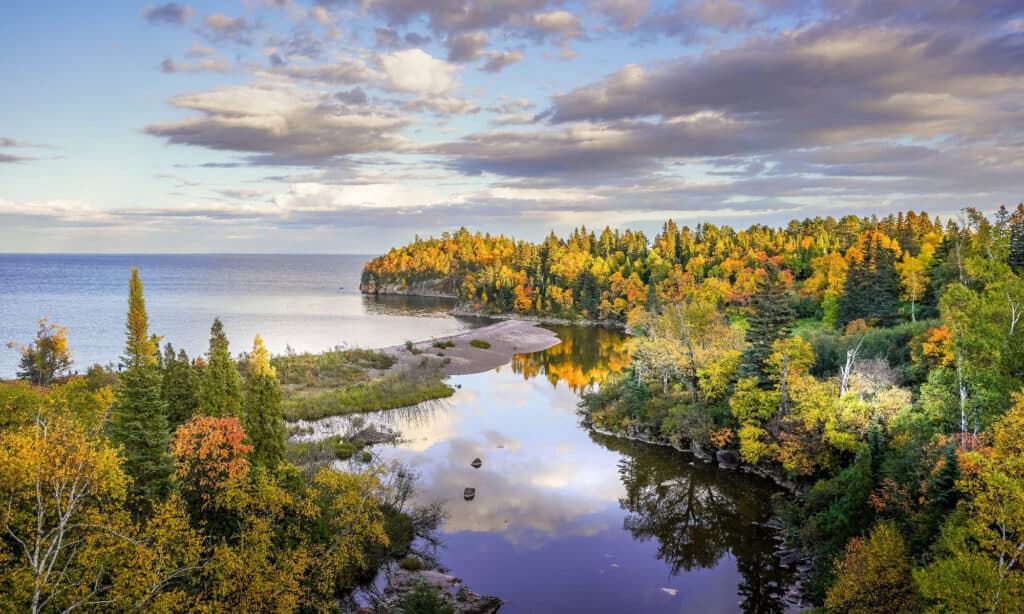
The average elevation of Lake Superior’s surface is 600 feet.
©iStock.com/Susan Rydberg
Lake Superior is the largest and northernmost of North America’s Great Lakes, the world’s largest freshwater lake by surface area and third-largest by volume, holding 10% of the world’s surface freshwater. The average elevation of the lake’s surface is 600 feet (183 meters) above sea level. Borders include Ontario, Canada, to the north, and states in the United States in other directions: Minnesota to the west, Wisconsin, and the Upper Peninsula of Michigan to the south. More than 80 species of fish thrive in Lake Superior, including trout, lake sturgeon, longnose sucker, and muskellunge.
14. Lake Michigan, Wisconsin
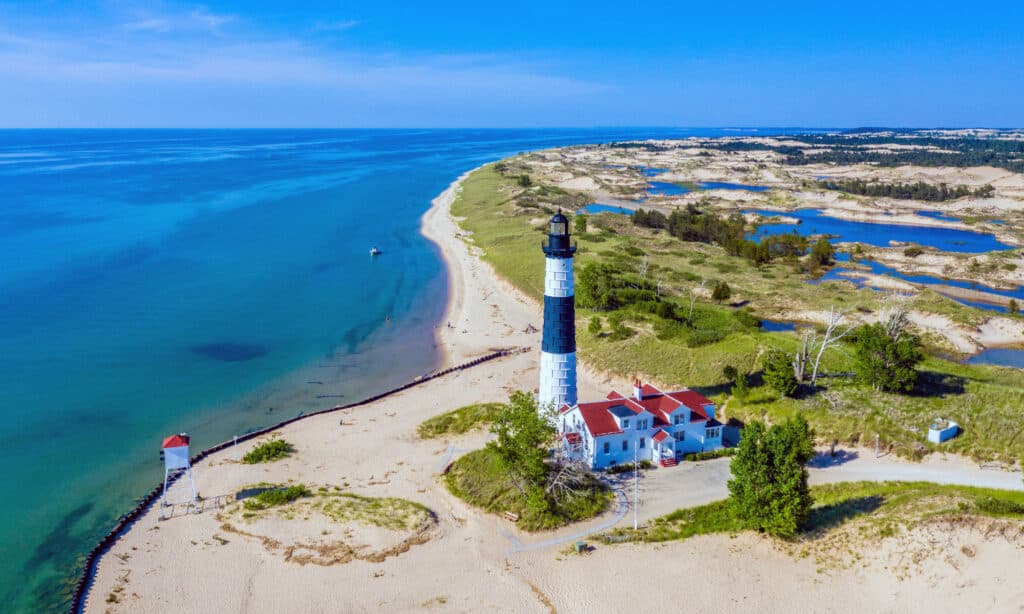
The deadliest of the Great Lakes, Lake Michigan, has a surface elevation of 578 feet.
©Frederick Millett/Shutterstock.com
Lake Michigan is one of the five Great Lakes of North America and the third-largest of these lakes by surface area. It is located in the states of Wisconsin, Illinois, Indiana, and Michigan from west to east. Its basin is connected to that of Lake Huron to the east through the narrow Straits of Mackinac, giving it the same surface elevation of 578 feet (176 meters) as its eastern counterpart; the two lakes are technically one. Lake Michigan has earned the “deadliest” title among the Great Lakes. Because of its configuration, powerful currents can emerge quickly, posing a danger to individuals nearby.
13. Lake Huron, Michigan
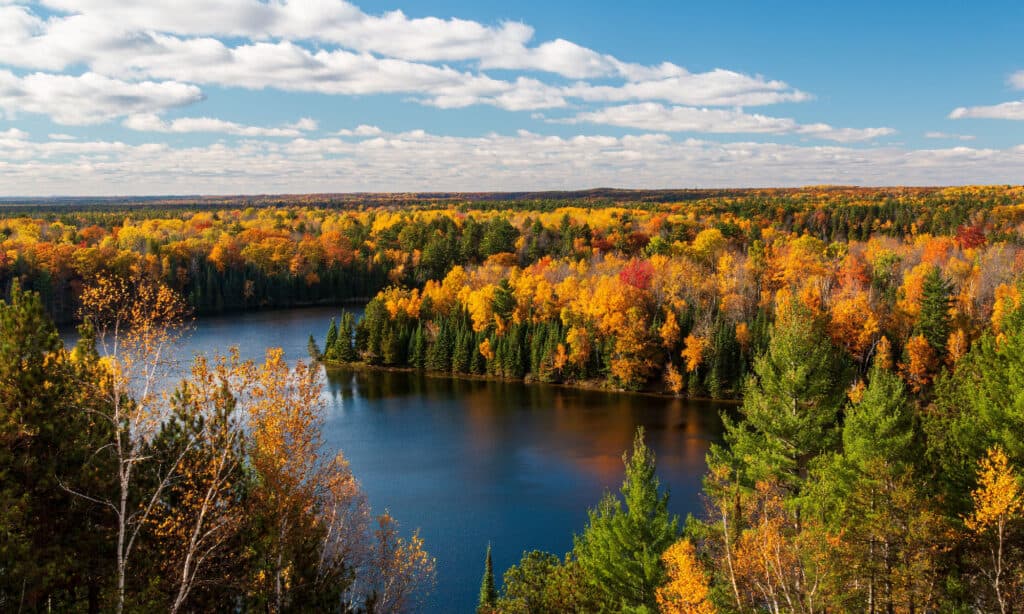
Sitting 578 feet above sea level, Lake Huron has beautiful beaches.
©iStock.com/Paul Massie Photography
Lake Huron, the second-largest of the Great Lakes, is at the top of the list thanks to its pristine turquoise waters, breathtaking beachfront sunrises, numerous lakeside parks, beautiful beaches, and ancient lighthouses. It has the same surface elevation as its westerly counterpart, Lake Michigan, at 578 feet (176 meters). The arrival of new invasive species, such as zebra mussels, the spiny water flea, and round gobies have recently harmed it. In recent years, chinook salmon catches have plummeted, while lake whitefish populations have declined and are in poor health.
12. Lake Erie, Michigan
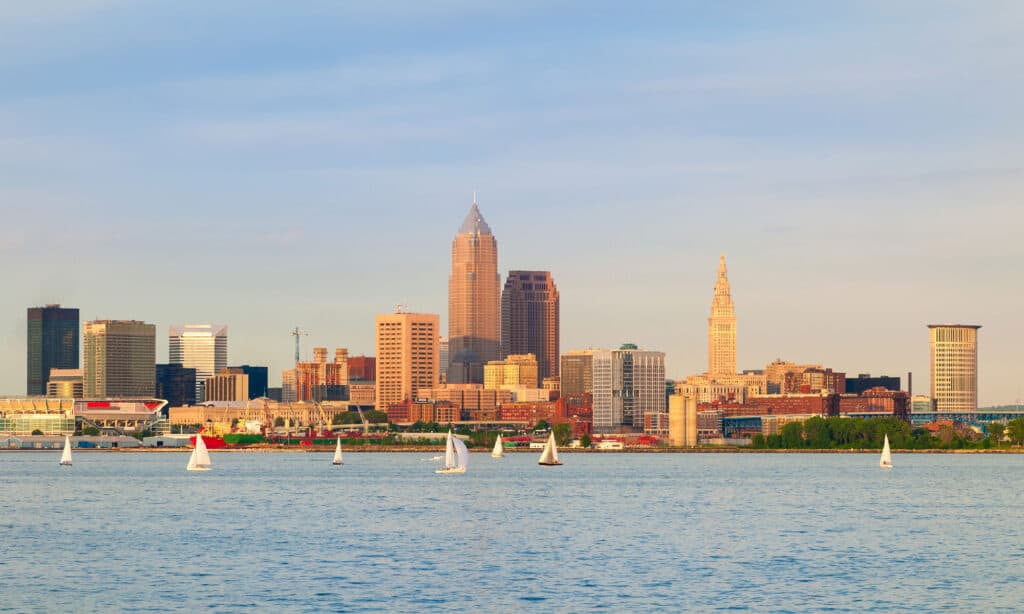
One of the largest lakes in the world, Lake Erie, has an elevation of 571 feet.
©iStock.com/PapaBear
Lake Erie is the fourth-largest of North America’s five Great Lakes and the eleventh-largest worldwide. It is the Great Lakes’ southernmost, shallowest, and smallest by volume. The Niagara River, which spins massive turbines near Niagara Falls in Lewiston, New York, and Queenston, Ontario, provides hydroelectric power to Canada and the United States and is the lake’s primary natural outflow. It is 571 feet (174 meters) above sea level on average. Sportfishing enthusiasts flock to Lake Erie, which has a thriving walleye fish population.
11. Lake Winnipesaukee, New Hampshire

Sitting 504 feet above sea level, Lake Winnipesaukee is the largest lake in New Hampshire.
©iStock.com/Gerry Fagan
Lake Winnipesaukee is the largest lake in New Hampshire, located in the Lakes Region near the foothills of the White Mountains. It is 504 feet (154 m) above sea level. Fishing in the lake is a fantastic experience at any time of year. It is also known for its annual Ice-Out Contest, in which people try to guess the earliest date that Mount Washington can safely leave her port in Center Harbor and motor to four other ports. Although no one has confirmed seeing one in decades, there were rattlesnakes on the island.
10. Seneca Lake, New York

Seneca Lake is the world’s lake trout capital and the backbone of the Finger Lakes wine industry.
©Nova Optics/Shutterstock.com
Seneca Lake is the largest of New York’s glacial Finger Lakes and the deepest glacial lake entirely within the state. As the world’s lake trout capital, it hosts the National Lake Trout Derby. Seneca Lake is a large body of water with a surface elevation of 445 feet (136 meters) and a depth of almost 600 feet (183 meters). Due to this, it produces the ideal setting for grape production and is the backbone of the Finger Lakes wine industry. It also features a typical aquatic population for big deep lakes in the northeast, with cold water fish like lake trout and landlocked Atlantic salmon and warm-water fish like smallmouth bass and yellow perch.
9. Cayuga Lake, New York

Named after the Cayuga people, Cayuga Lake is the longest of the glacial Finger Lakes in central New York.
©iStock.com/Jonathan W. Cohen
Cayuga Lake is the longest of the glacial Finger Lakes in central New York, with the second-largest surface area (slightly less than Seneca Lake) and volume. It has a surface elevation of 381 feet (116 meters). The Cayuga people were the first settlers in the area, hence the lake’s name. The fish population is under management, and substantial sport fishing is practiced, with anglers targeting smelt, lake trout, and smallmouth bass.
8. Oneida Lake, New York
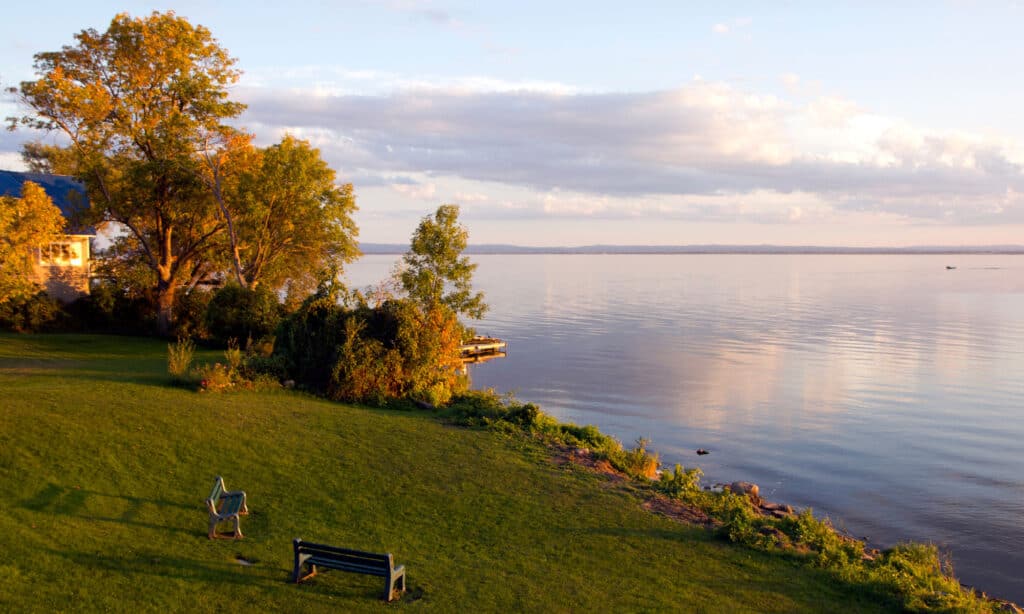
Oneida Lake is the largest lake in New York with an elevation of 368 feet.
©iStock.com/Mirages-nl
With a total size of 79.8 square miles (207 square kilometers), Oneida Lake is the largest lake in the state of New York and lies at a total elevation of 368 feet (118 meters). Oneida Lake is sometimes referred to as the “thumb” of the Finger Lakes, even though it is not geologically one of them. Walleye can be found in shallow water in spawning regions and streams in the spring. Due to its shallowness, its surface freezes hard in the winter. Therefore, ice fishing and snowmobiling are popular winter activities.
7. West Thompson Lake, Connecticut
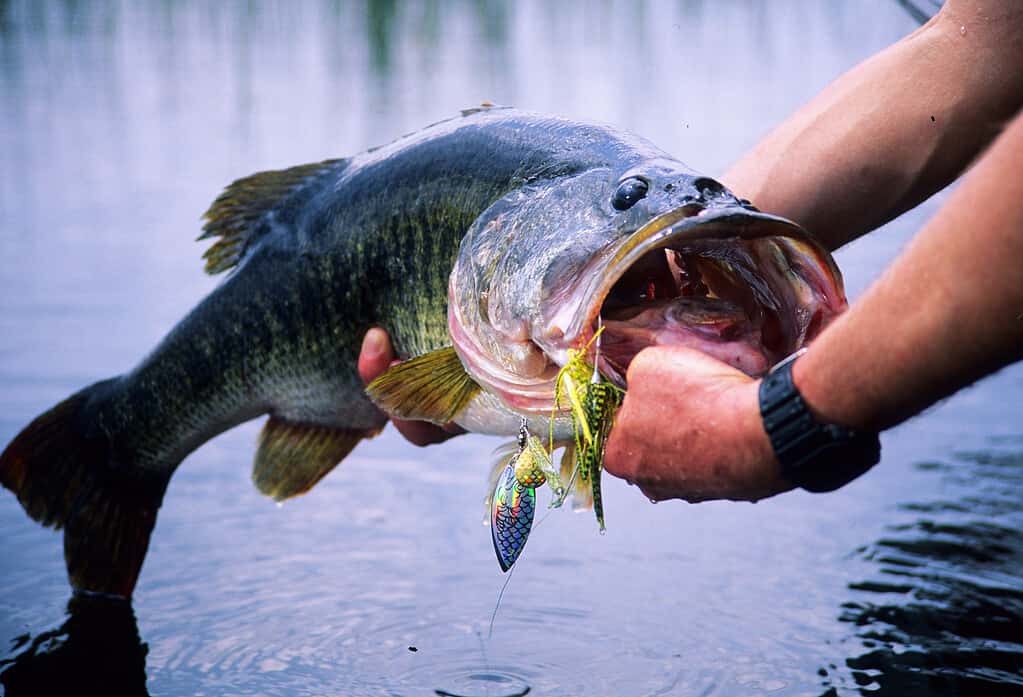
Largemouth bass are among the warm-water fish found in West Thompson Lake.
©iStock.com/stammphoto
West Thompson Lake is a 200-acre lake in Thompson, Windham County, Connecticut, and has a total storage capacity of 342 million gallons of floodwater. It has a surface elevation of 306 feet (92 meters). Largemouth and smallmouth bass, pickerel, perch, carp, and sunfish are common warm-water fish species in the lake. It is home to natural resources, including habitats, landscapes, plant life, and wildlife. Park Rangers are in charge of the forest surrounding the lake, which consists of white pine, oak, birch, and maple.
6. Lake Ontario, New York

Of the five Great Lakes, Lake Ontario has the lowest mean surface elevation.
©Michael J. Eves/Shutterstock.com
Lake Ontario is one of North America’s five Great Lakes. Ontario, Canada, surrounds the north, west, and southwest, and on the south and east, bordered by New York, USA, whose water borders meet in the middle of the lake. As the last lake in the Great Lakes hydrologic chain, Lake Ontario has the lowest mean surface elevation of the lakes at 243 feet (74 meters) above sea level. The Great Lakes watershed has a diversity of birds, fish, reptiles, amphibians, and plants, and Lake Ontario is an essential part of that richness.
5. Lake Altamaha, Florida
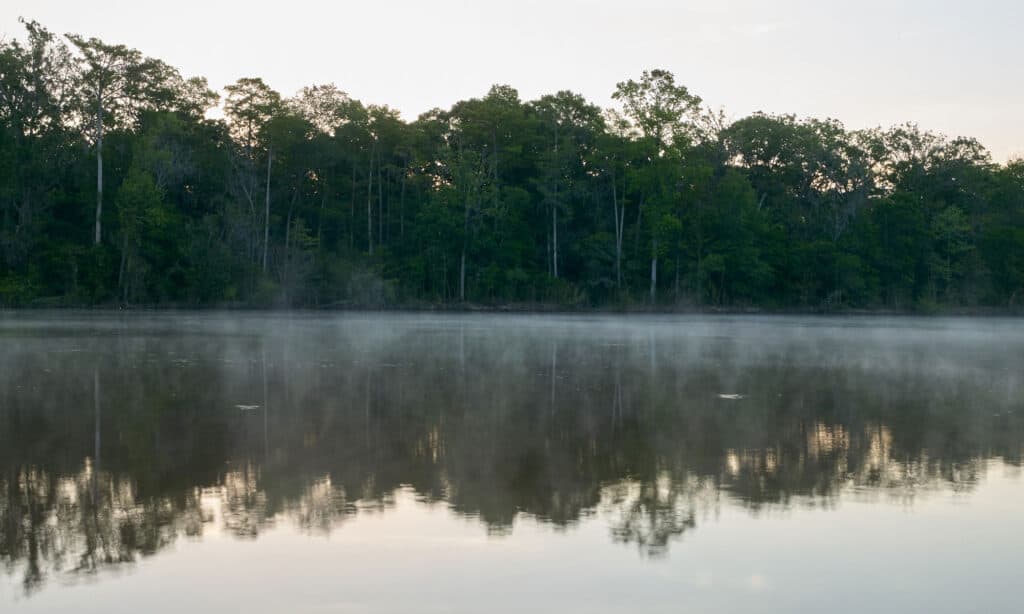
Having a surface elevation of 115 feet, Lake Altamaha contains
blue catfish
and gar.
©iStock.com/Colby Lysne
Lake Altamaha is located just east of Highway US 27 on the south shore of Lake Wales, Florida, and has a surface elevation of 115 feet (35 meters). The public has access to Miami Street and US 27. However, there is no public swimming beach or boat ramp on this lake’s side. The lake contains blue catfish, bullhead, and gar.
4. Lake Champlain, Vermont
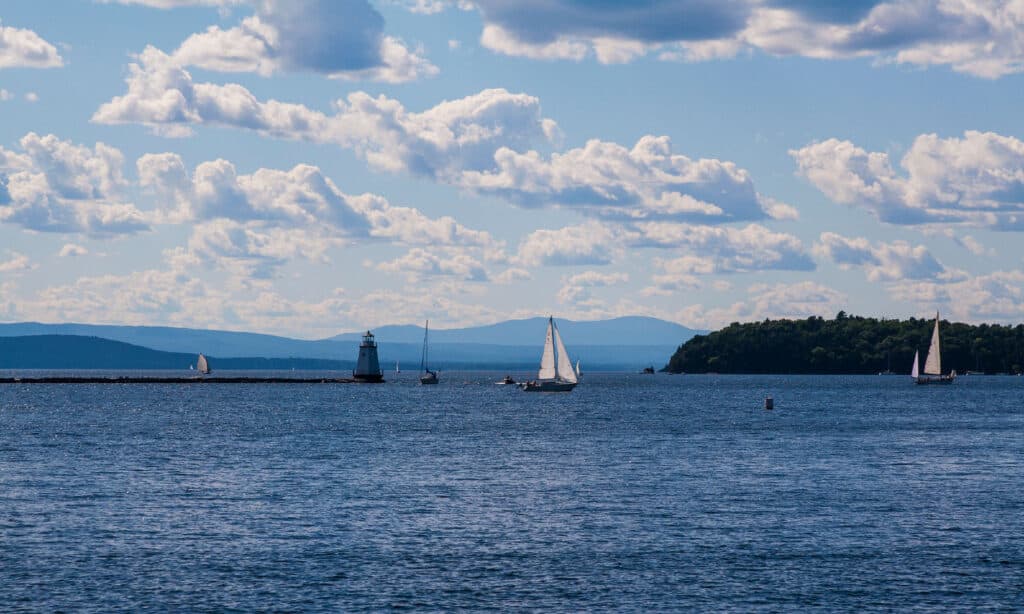
Sometimes referred to as the sixth Great Lake, Lake Champlain has a surface elevation of 95 to 100 feet.
©Mark Castiglia/Shutterstock.com
Lake Champlain is a natural freshwater lake in North America, primarily located within the United States (Vermont and New York), with a surface elevation of 95 to 100 feet (29 to 30 meters). Lake Champlain is sometimes referred to as “The Sixth Great Lake” because of its proximity to the St. Lawrence Seaway via the Richelieu River and the existence of the Champlain Canal. Lampreys are native to the area, but their numbers have exploded to the point where they killed nearly all lake trout and 70 to 80 percent of salmon in 2006. Pesticides against the lamprey have reduced damage to other fish to 35% of salmon and 31% of lake trout.
3. Lake Marion, South Carolina
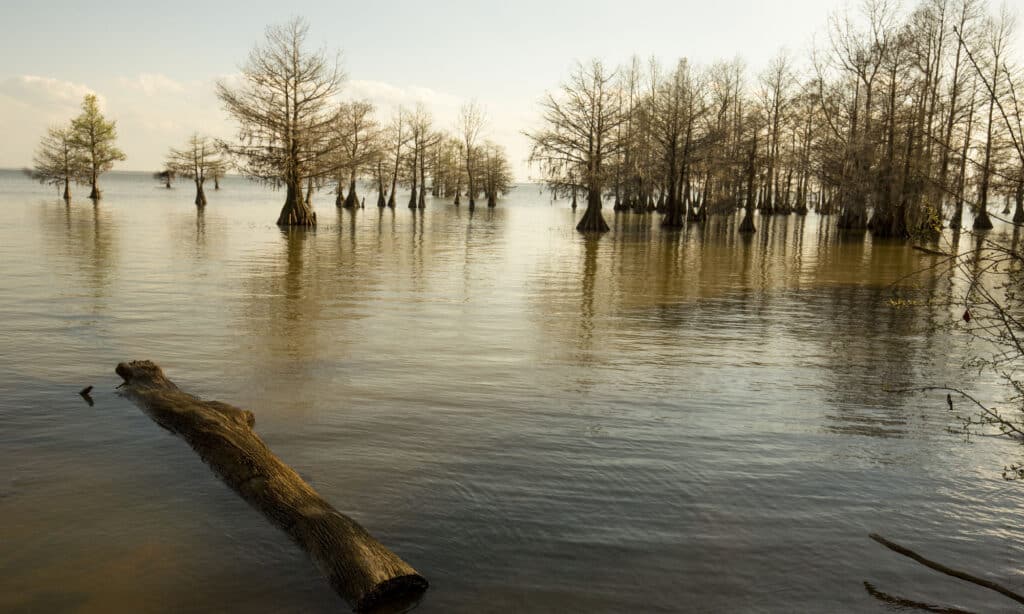
South Carolina’s largest lake, Lake Marion, has a surface elevation of 76 feet.
©Jeff Holcombe/Shutterstock.com
Lake Marion is South Carolina’s largest lake, centrally located and encompassing five counties, commonly referred to as the state’s inland sea. It has only a surface elevation of 76 feet (23 meters). In the 1940s, the creation of the Santee River to provide hydroelectric power resulted in Lake Marion, one of the United States’ 50 largest lakes, whether natural or man-made reservoirs. It is home to hundreds of alligators who prefer to live in the shallower, swampy areas of the lake.
2. Iliamna Lake, Alaska
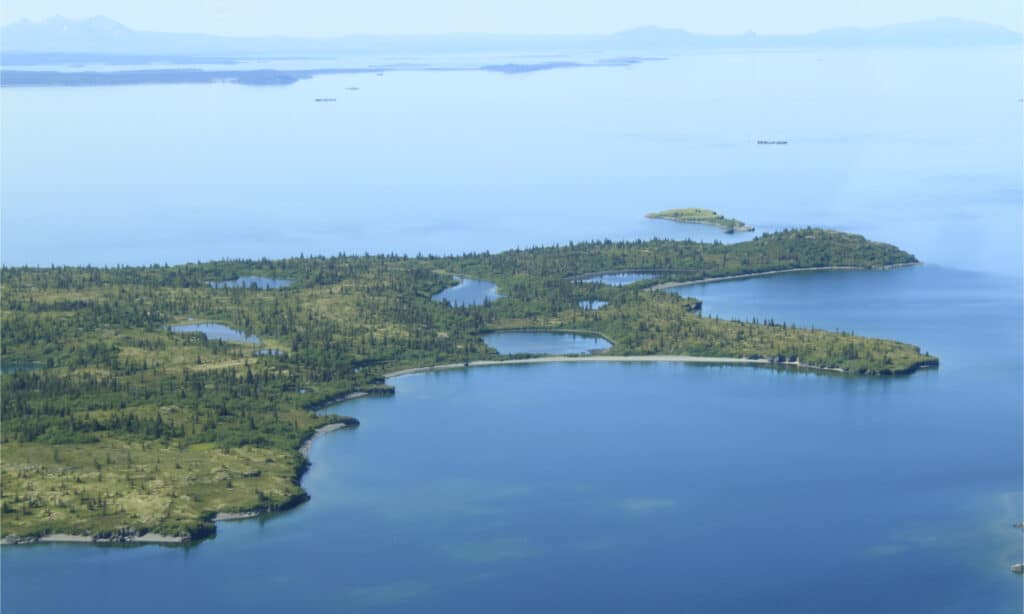
Alaska’s largest body of freshwater has an elevation of 46 feet.
©Nessie91/Shutterstock.com
Iliamna Lake, Alaska’s largest body of freshwater and one of the most productive systems for sockeye salmon in the Bristol Bay region, is at least 46 feet (14 meters) of surface elevation. It is home to hundreds of harbor seals, and its tributaries are critical spawning grounds for Chinook, coho, and sockeye salmon. Locals have a variety of tales about the supposed Iliamna Lake Monster, an undiscovered aquatic creature. There is a suggestion that the sightings could represent an undetected population of white sturgeon.
1. Lake Okeechobee, Florida
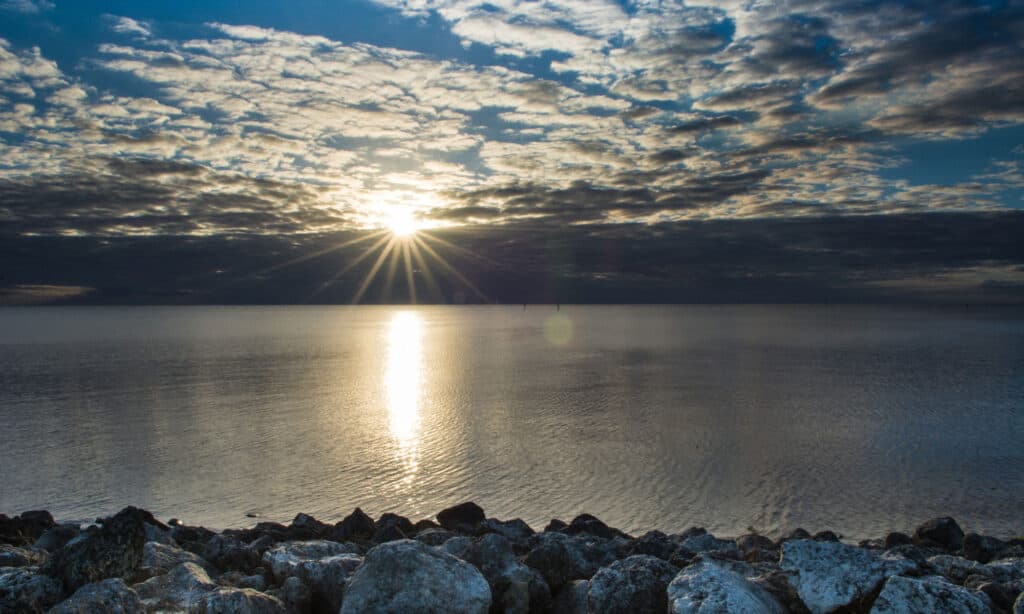
Lake Okeechobee, Florida’s largest freshwater lake, has an elevation of 18 feet.
©Allison Michael/Shutterstock.com
The largest freshwater lake in Florida is Lake Okeechobee, often known as Florida’s Inland Sea. With only 18 feet (5.5 meters) of elevation, it is the lowest lake in the United States. The most common fish in this lake are largemouth bass, crappie, and bluegill. However, the current algae on the lake includes 120 parts per billion of the toxin microcystin, making the lake water too dangerous to touch, swallow, or inhale.
Summary of 15 Lowest Elevation Lakes in the United States
Here’s a recap of the 15 lakes with lowest elevation located in the U.S.
| Rank | Lake | Location | Elevation |
|---|---|---|---|
| 1 | Lake Okeechobee | Florida | 18 feet |
| 2 | Iliamna Lake | Alaska | 46 feet |
| 3 | Lake Marion | South Carolina | 76 feet |
| 4 | Lake Champlain | Vermont | 95-100 feet |
| 5 | Lake Altamaha | Florida | 115 feet |
| 6 | Lake Ontario | New York | 243 feet |
| 7 | West Thompson Lake | Connecticut | 306 feet |
| 8 | Oneida Lake | New York | 368 feet |
| 9 | Cayuga Lake | New York | 381 feet |
| 10 | Seneca Lake | New York | 445 feet |
| 11 | Lake Winnipesaukee | New Hampshire | 504 feet |
| 12 | Lake Erie | Michigan | 571 feet |
| 13 | Lake Huron | Michigan | 578 feet |
| 14 | Lake Michigan | Wisconsin | 578 feet |
| 15 | Lake Superior | Minnesota | 600 feet |
The photo featured at the top of this post is © iStock.com/Paul Massie Photography
Thank you for reading! Have some feedback for us? Contact the AZ Animals editorial team.






